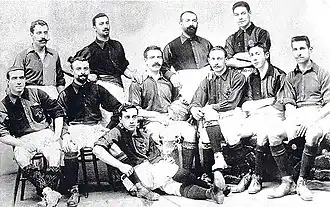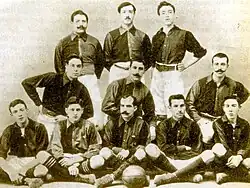Luis de Ossó
 Ossó (seated, first from the left) in 1903 | |||
| Personal information | |||
|---|---|---|---|
| Full name | Luis de Ossó Serra | ||
| Birth name | Lluís d'Ossó i Serra | ||
| Date of birth | 1877 | ||
| Place of birth | Barcelona, Catalonia, Spain | ||
| Date of death | 1 February 1931 (aged 53–54) | ||
| Place of death | Barcelona, Catalonia, Spain | ||
| Position(s) | Forward | ||
| Senior career* | |||
| Years | Team | Apps | (Gls) |
| 1899–1905 | FC Barcelona | 72 | (68) |
| 1900–1903 | FC Barcelona B | ||
| * Club domestic league appearances and goals | |||
Luis de Ossó Serra (1877 – 1 February 1931) was a Spanish footballer who played as a forward for FC Barcelona.[1] He was one of the most important footballers in the amateur beginnings of FC Barcelona, being among the 12 founders of the club in 1899, and then serving the club as a forward for six years, netting 68 goals in 72 appearances, thus contributing decisively in the conquest of Barça's first official titles, 1901–02 Copa Macaya, which was the club's first-ever official title, 1902–03 Copa Barcelona and the 1904–05 Catalan championship.[1]
Early life
Luis de Ossó was born in the Catalonian town of Barcelona in 1877, as the son of Jaume de Ossó Cervelló and Teresa Serra Sandiumenge, both originally from Vinebre in the south of Tarragona.[2] His father's brother, Saint Enrique de Ossó i Cervelló, was the founding priest of the Congregation of the Teresianas, being canonized by Pope John Paul II in 1993.[1] He lived for a few years at Carrer del Duc.[2]
Career
Founding FC Barcelona
On 29 November 1899, Ossó was one of the twelve men who founded Futbol Club Barcelona in the historic meeting held at the Gimnasio Solé,[2][3] in which the 22-year-old Ossó was elected as the club's first secretary, a position that he held for two years, until 1901, a notable feat back when changes in the board were very constant.[1][4] His presence in the meeting was most likely a result of his connection with the gym's owner, Manuel Solé, who was also from the south of Tarragona.[5] He is considered the first patron of the club because he made Barça's very first economic investments,[1] such as securing a lease for a piece of land next to the Hotel Casanovas (where today the Hospital de Sant Pau stands), which served as the club's second playing field between 1900 and 1901.[3]
Ten days later, on 8 December, Ossó went down in history as one of the ten footballers who played in Barcelona's official debut at the Velódromo de la Bonanova, which ended in a 0–1 loss to a team known as Team Anglès, which consisted of members of the British colony living in Barcelona.[6][7] The owner of a printing press, Ossó was a contributor to the weekly newspaper Los Deportes,[2][6] where he published the news of Barça and chronicles of its first matches, always under the pseudonym Un delantero ("A striker").[2] In the first issue of the year 1900, he wrote a article asking what football should be called, since he did not like the term juego de pelota, but no one was able to answer him, so he continued calling it foot-ball.[2] According to Alberto Maluquer, Ossó wrote a diary in which he reviewed the most important events of Barça's early years, basically acting as a historian of those years, but this work was lost in the fire that broke out many years later in the family printing house.[2][4] He was responsible, together with Gamper and Walter Wild, for drafting the club's statutes.[8]
Titles with both the first and second teams

Unlike Joan Gamper, who envisaged a club that served as a means of social integration and was open to everyone,[3] Ossó was more interested in making Barça a team of purely Catalans and Spaniards as a means to expel Protestants, owning it to his kinship with Saint Enrique of Ossó, but it was only after Gamper's departure from the club in December 1900 that Ossó was able to make Barça play its first-ever match without any foreigners against Sociedad Española, the forerunner of Espanyol.[2][5] During the presidency of Bartomeu Terrades, Ossó officially created the club's second and third teams, which was mainly made up of Catalans.[1][4][8] He refused to play for the first team several times, as he instead preferred to play with the second, where he was the captain of a team featuring the likes of Alfonso Albéniz, Luis Puelles, and fellow club founders Josep Llobet and Pere Cabot.[9][10] With the club's second team, Ossó won lesser tournaments organized by the Spanish Gymnastics Federation, such as the 1902 Medalla del Ayuntamiento[9][11] and the 1902 Copa Pergamino.

Ossó participated in the conquest of the very first official titles of FC Barcelona: The inaugural edition of the Copa Macaya, the very first football competition played on the Iberian Peninsula, which ended in a narrow runner-up finish to Hispania AC.[12] In the following season, however, Ossó played a crucial role in Barça's first-ever title, the 1901–02 Copa Macaya, netting once in a 9–0 win over Universitary SC.[13] In the 1903–04 season, he briefly worked as a referee.[14] He went on to win the 1903 Copa Barcelona and the 1904–05 Catalan championship.[4]
On 1 May 1904, Ossó was a member of Barça's first-ever trip abroad, starting in a friendly match against Stade Olympien des Etudiants de Toulouse (SOET) in Toulouse, an excursion that was well documented in Los Deportes in a chronicle that was almost certainly written by Ossó.[15] Accounts on his tally for Barça differ, with some sources stating that he scored 63 goals in 70 matches,[2] while others state 68 goals in 72 matches, including 11 goals in 16 official matches.[1]
Legend of the origin of Barça's shield
Traditionally, Ossó has been associated with the origin of the current blaugrana shield, which was created in a board meeting in 1901, when the secretary Ossó shouted: "Això is a pot of grills!" ("This is a pot of grills!"), a phrase that inspired Gamper to draw a shield in the shape of a pot, later adding the azulgrana colors.[16] This version of events is now considered a myth and it is believed that Barça's current coat of arms was actually drawn by Carles Comamala.[17]
Outside football
Like so many other pioneer sportsmen of his time, Ossó practiced multiple modalities, such as cycling, hunting, as well as sailing at Club Regatas de Barcelona, which he enjoyed alongside fellow Barça founder Josep Llobet.[8] He might have known Alberto Serra, a former Regatas member and once a director at Los Deportes, although there is little evidence for it. He also practiced horse riding, hiking, tennis, and skating, being a member of Skating-Ring and Club Velocipédico.[9]
Death
Luis de Ossó died in Barcelona on 1 February 1931, at the age of 54, unmarried and without children.[2][18]
Honours
FC Barcelona
- Copa Macaya:
- Copa Barcelona:
- Champions: 1903
- Catalan championship
- Champions (1): 1904–05
FC Barcelona B
- Concurso Pergamí
- Champions: 1902
- Medalla del Ayuntamiento
- Champions: 1902
References
- ^ a b c d e f g "Lluís D'ossó Serra stats". players.fcbarcelona.com. Archived from the original on 18 October 2022. Retrieved 18 October 2022.
- ^ a b c d e f g h i j "Els onze apòstols de Gamper (1)" [The eleven apostles of Gamper (1)]. www.lesportiudecatalunya.cat (in Catalan). 9 November 2016. Archived from the original on 29 February 2024. Retrieved 20 July 2025.
- ^ a b c "1899–1909. Foundation and survival". FC Barcelona. Archived from the original on 13 May 2021. Retrieved 18 October 2022.
- ^ a b c d "Lluís d'Ossó Serra". www.enciclopedia.cat (in Catalan). Archived from the original on 3 December 2024. Retrieved 20 July 2025.
- ^ a b "Las polémicas en torno a la historia del FC Barcelona (I): El nacimiento del FC Barcelona" [The controversies surrounding the history of FC Barcelona (I): The birth of FC Barcelona]. www.cuadernosdefutbol.com (in Spanish). CIHEFE. 16 September 2018. Archived from the original on 24 April 2025. Retrieved 20 July 2025.
- ^ a b "Los diez pioneros del Barça: el primer partido" [The ten pioneers of Barça: the first game]. www.mundodeportivo.com (in Spanish). 29 November 2019. Archived from the original on 29 February 2024. Retrieved 20 July 2025.
- ^ "Barcelona 0–1 Team Anglès". La Vanguardia. 9 December 1899. Archived from the original on 20 September 2022. Retrieved 18 October 2022.
- ^ a b c "Els onze apòstols de Gamper (2)" [Gamper's eleven apostles (2)]. www.lesportiudecatalunya.cat (in Hungarian). 10 November 2016. Archived from the original on 4 January 2017. Retrieved 11 February 2024.
- ^ a b c "Siluetas" [Silhouettes]. arca.bnc.cat (in Catalan). Los Deportes. 1 June 1902. p. 6. Retrieved 20 July 2025.
- ^ "FutbolBarça i Maresme units des del 1899" [Barça and Maresme united since 1899]. esportiumaresme.cat (in Catalan). 2 March 2022. Archived from the original on 16 September 2024. Retrieved 20 July 2025.
- ^ "Concurso medalla "F. G. E." - Partidos del domingo anterior" [Medal competition "F.G.E." - Matches from the previous Sunday]. arca.bnc.cat (in Catalan). Los Deportes. 4 May 1902. p. 7. Archived from the original on 21 February 2025. Retrieved 20 July 2025.
- ^ "Primera edición de la Copa Macaya Enero-Abril 1901" [First edition of the Macaya Cup January-April 1901]. www.cuadernosdefutbol.com (in Spanish). CIHEFE. 1 June 2014. Archived from the original on 4 June 2025. Retrieved 20 July 2025.
- ^ "Partidos del Barça de 1901-02" [Barça matches of 1901-02]. www.webdelcule.com (in Spanish). Archived from the original on 11 November 2022. Retrieved 20 July 2025.
- ^ "D'Ossó, Lluís d'Ossó Serra - Referee". www.bdfutbol.com. Retrieved 20 July 2025.
- ^ "La primera salida al extranjero del Barça" [Barça's first trip abroad]. www.sport.es (in Spanish). 1 May 2021. Archived from the original on 10 February 2025. Retrieved 20 July 2025.
- ^ "foro azulgrana/blaugrana: Origen de la forma del escudo del FC Barcelona" [azulgrana/blaugrana forum: Origin of the form of the shield of FC Barcelona]. foroazulgranablaugrana.blogspot.com (in Spanish). 15 June 2015. Archived from the original on 18 October 2022. Retrieved 18 October 2022.
- ^ "El escudo" [The shield] (in Spanish). FC Barcelona. 18 July 2014. Archived from the original on 18 July 2014. Retrieved 18 October 2022.
- ^ "Obituario de Luis de Ossó" [Obituary of Luis de Ossó] (PDF). hemeroteca-paginas.lavanguardia.com (in Spanish). La Vanguardia. 20 February 1931. Archived (PDF) from the original on 4 March 2016. Retrieved 18 October 2022.
External links
- Luis de Ossó at BDFutbol